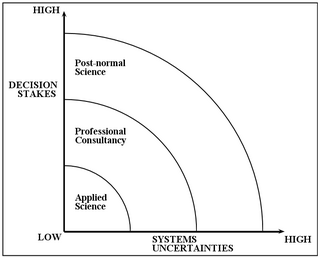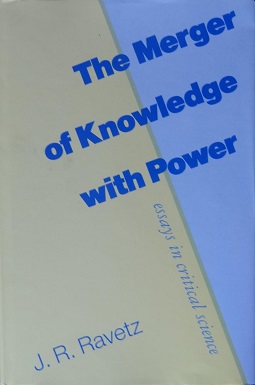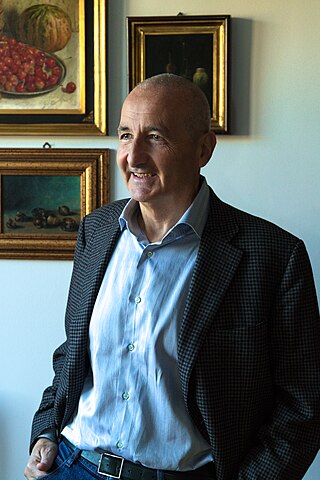Related Research Articles
Risk assessment determines possible mishaps, their likelihood and consequences, and the tolerances for such events. The results of this process may be expressed in a quantitative or qualitative fashion. Risk assessment is an inherent part of a broader risk management strategy to help reduce any potential risk-related consequences.
Sensitivity analysis is the study of how the uncertainty in the output of a mathematical model or system can be divided and allocated to different sources of uncertainty in its inputs. A related practice is uncertainty analysis, which has a greater focus on uncertainty quantification and propagation of uncertainty; ideally, uncertainty and sensitivity analysis should be run in tandem.

Post-normal science (PNS) was developed in the 1990s by Silvio Funtowicz and Jerome R. Ravetz. It is a problem-solving strategy appropriate when "facts [are] uncertain, values in dispute, stakes high and decisions urgent", conditions often present in policy-relevant research. In those situations, PNS recommends suspending temporarily the traditional scientific ideal of truth, concentrating on quality as assessed by internal and extended peer communities.
In science, engineering, and research, expert elicitation is the synthesis of opinions of authorities of a subject where there is uncertainty due to insufficient data or when such data is unattainable because of physical constraints or lack of resources. Expert elicitation is essentially a scientific consensus methodology. It is often used in the study of rare events. Expert elicitation allows for parametrization, an "educated guess", for the respective topic under study. Expert elicitation generally quantifies uncertainty.

Jerome (Jerry) Ravetz is a philosopher of science. He is best known for his books analysing scientific knowledge from a social and ethical perspective, focussing on issues of quality. He is the co-author of the NUSAP notational system and of Post-normal science. He is currently an Associate Fellow at the Institute for Science, Innovation and Society, University of Oxford.

In simple terms, risk is the possibility of something bad happening. Risk involves uncertainty about the effects/implications of an activity with respect to something that humans value, often focusing on negative, undesirable consequences. Many different definitions have been proposed. The international standard definition of risk for common understanding in different applications is "effect of uncertainty on objectives".
A food safety-risk analysis is essential not only to produce or manufacture high quality goods and products to ensure safety and protect public health, but also to comply with international and national standards and market regulations. With risk analyses food safety systems can be strengthened and food-borne illnesses can be reduced. Food safety risk analyses focus on major safety concerns in manufacturing premises—not every safety issue requires a formal risk analysis. Sometimes, especially for complex or controversial analyses, regular staff is supported by independent consultants.
Analytica is a visual software developed by Lumina Decision Systems for creating, analyzing and communicating quantitative decision models. It combines hierarchical influence diagrams for visual creation and view of models, intelligent arrays for working with multidimensional data, Monte Carlo simulation for analyzing risk and uncertainty, and optimization, including linear and nonlinear programming. Its design is based on ideas from the field of decision analysis. As a computer language, it combines a declarative (non-procedural) structure for referential transparency, array abstraction, and automatic dependency maintenance for efficient sequencing of computation.
P-boxes and probability bounds analysis have been used in many applications spanning many disciplines in engineering and environmental science, including:
Sensitivity auditing is an extension of sensitivity analysis for use in policy-relevant modelling studies. Its use is recommended - i.a. in the European Commission Impact assessment guidelines and by the European Science Academies- when a sensitivity analysis (SA) of a model-based study is meant to demonstrate the robustness of the evidence provided by the model in the context whereby the inference feeds into a policy or decision-making process.

The Merger of Knowledge with Power: Essays in Critical Science is a book written in 1990 by Jerome Ravetz.

Uncertainty and Quality in Science for Policy is a 1990 book by Silvio Funtowicz and Jerome Ravetz, in which the authors explain the notational system NUSAP and applies it to several examples from the environmental sciences. The work is considered foundational to the development of post-normal science.

Silvio O. Funtowicz is a philosopher of science active in the field of science and technology studies. He created the NUSAP, a notational system for characterising uncertainty and quality in quantitative expressions, and together with Jerome R. Ravetz he introduced the concept of post-normal science. He is currently a guest researcher at the Centre for the Study of the Sciences and the Humanities (SVT), University of Bergen (Norway).

Science on the verge is a book written in 2016 by group of eight scholars working in the tradition of Post-normal science. The book analyzes the main features and possible causes of the present science's crisis.

The No Nonsense Guide to Science is a 2006 book on Post-normal science (PNS). It was written by American born British historian and philosopher of science Jerome Ravetz.
Quantitative storytelling (QST) is a systematic approach to exploring the many frames potentially legitimate in a scientific study or controversy. QST assumes that, in an interconnected society, multiple frameworks and worldviews are legitimately upheld by different entities and social actors. QST looks critically at models used in evidence-based policy. Such models are often reductionist in that tractability is achieved at the expense of suppressing available evidence. QST suggests corrective approaches to this practice.
Ossein is the organic extracellular matrix of bone, which is made of 95% collagen. This substance is used in industry for the production of gelatin and bone glue.
Sensitivity analysis studies the relation between the uncertainty in a model-based the inference and the uncertainties in the model assumptions. Sensitivity analysis can play an important role in epidemiology, for example in assessing the influence of the unmeasured confounding on the causal conclusions of a study. It is also important in all mathematical modelling studies of epidemics.

Andrea Saltelli is an Italian scholar specializing in quantification using statistical and sociological tools. He has extended the theory of sensitivity analysis to sensitivity auditing, focusing on physical chemistry, environmental statistics, impact assessment and science for policy. He is currently Counsellor at the UPF Barcelona School of Management.
The concept of Extended peer community belongs to the field of Sociology of science, and in particular the use of science in the solution of social, political or ecological problems. It was first introduced by in the 1990s by Silvio Funtowicz and Jerome R. Ravetz. in the context of what would become Post-normal science. An Extended peer community is intended by these authors as a space where both credentialed experts from different disciplines and lay stakeholders can discuss and deliberate.
References
- ↑ Funtowicz, S. & Ravetz J., 1990, Uncertainty and Quality in Science for Policy, Kluwer Academic Publishers, Dordrecht.
- ↑ van der Sluijs, J., Craye, M., Funtowicz, S., Kloprogge, P., Ravetz, J., and Risbey, J. (2005) Combining Quantitative and Qualitative Measures of Uncertainty in Model based Environmental Assessment: the NUSAP System, Risk Analysis, 25 (2). p. 481-492.
- ↑ Van Der Sluijs, J.P., Wardekker, J.A., 2015, Critical appraisal of assumptions in chains of model calculations used to project local climate impacts for adaptation decision support - The case of Baakse Beek, Environmental Research Letters, 10(4), doi:10.1088/1748-9326/10/4/045005.
- ↑ Lorenz, S; Dessai, S; Paavola, J; Forster, P M., 2015, The communication of physical science uncertainty in European National Adaptation Strategies, Climatic Change132.1 (Sep 2015): 143-155.
- ↑ Zhu, Q., Xu, X., Gao, C., Ran, Q.-H., Xu, Y.-P., 2013, Qualitative and quantitative uncertainties in regional rainfall frequency analysis, Journal of Zhejiang University: Science A, Volume 16, Issue 3, 2015, Pages 194-203.
- ↑ Kloprogge, P., Van der Sluijs, J.P., Petersen, A.C., 2011, A method for the analysis of assumptions in model-based environmental assessments, Environmental Modelling and Software, 26(3), 289-301.
- ↑ Ides Boone, Yves Van der Stede, Jeroen Dewulf, Winy Messens, Marc Aerts, Georges Daube and Koen Mintiens, 2010, NUSAP: a method to evaluate the quality of assumptions in quantitative microbial risk assessment, Journal of Risk Research, 13(3), 337-352.
- ↑ Christine Louise Berner, Roger Flage, 2016, Comparing and integrating the NUSAP notational scheme with an uncertainty based risk perspective, Reliability Engineering & System Safety, 156, Pages 185–194.
- ↑ Bouwknegt M and Havelaar AH, 2015. Uncertainty assessment using the NUSAP approach: a case study on the EFoNAO tool. EFSA supporting publication 2015: EN-663, 20 pp.
- ↑ EFSA BIOHAZ Panel (EFSA Panel on Biological Hazards), 2015. Scientific Opinion on the development of a risk ranking toolbox for the EFSA BIOHAZ Panel. EFSA Journal 2015;13(1):3939, 131 pp. doi:10.2903/j.efsa.2015.3939.
- ↑ Funtowicz, S.O. and Jerome R. Ravetz (1991). "A New Scientific Methodology for Global Environmental Issues." In Ecological Economics: The Science and Management of Sustainability. Ed. Robert Costanza. New York: Columbia University Press: 137–152.
- ↑ Funtowicz, S. O., & Ravetz, J. R. 1992. Three types of risk assessment and the emergence of postnormal science. In S. Krimsky & D. Golding (Eds.), Social theories of risk (pp. 251–273). Westport, CT: Greenwood.
- ↑ Funtowicz, S. O. & Ravetz, J. R. 1993. Science for the post-normal age. Futures, 25(7), 739–755.
- ↑ S. 0. Funtowicz and J.R. Ravetz, 1992, Uncertainty and Quality in Science for Policy, Radical Statistics, 50 (Spring '92), 31-34.